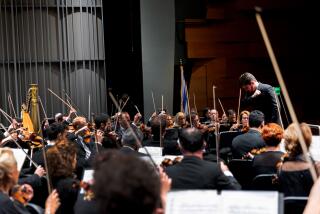McDermott pushes Prokofiev to limit
Anne-Marie McDermott has a deep passion for Prokofiev. She talks about him with febrile energy, the words tumbling out almost faster than one can take them in. She plays his piano sonatas that way, too, pushing her Steinway just about to its dynamic limits, where fortes become triple fortes, where lyrical passages surge and heave.
In other words, McDermott is quite a show unto herself. But most importantly for Prokofiev -- whose death 50 years ago is being commemorated this season -- she brought riveting and sometimes surprising insights to her cycle of nine sonatas at UCLA’s Schoenberg Hall over the weekend.
No major 20th century composer made a bigger contribution to the supposedly played-out piano sonata idiom than Prokofiev, who covered a wider range of stylistic and emotional territory than he has been given credit for. McDermott distributed the cycle over three concerts, each ending with one of the big wartime sonatas (Nos. 6, 7 and 8).
The pianist prefaced each work with a demonstration lecture, and the performances Friday night carried out her intentions to the letter. First, she played the brief Sonata No. 1 -- which contains hardly a trace of Prokofiev’s voice -- as if it were long-lost Rachmaninoff.
The Sonata No. 9 was once thought of as a sign that Prokofiev was already starting to develop a simpler, more passive style a year ahead of the infamous 1948 Zhdanov decrees that blighted the rest of his life. Yet McDermott provocatively sees the piece as “experimental,” even “psychotic,” playing the opening movement as if wandering in a haze, flashing back to the stabbing brutality of earlier sonatas, bringing hammering grotesquery to a finale that drifts back into a hallucination. And she concluded with a bristling treatment of the Sonata No. 8.
More to Read
The biggest entertainment stories
Get our big stories about Hollywood, film, television, music, arts, culture and more right in your inbox as soon as they publish.
You may occasionally receive promotional content from the Los Angeles Times.










